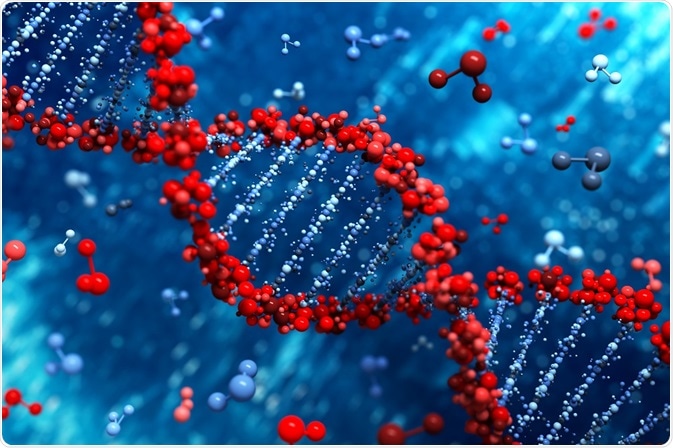Double-stranded DNA breaks occur through errors in DNA replication and exposure to harmful agents such as ionizing radiation. This type of DNA damage must be repaired to maintain genomic integrity and prevent uncontrolled cell growth.
 Credit: Leigh Prather/Shutterstock.com
Credit: Leigh Prather/Shutterstock.com
Homologous recombination is one mechanism for repairing double-stranded DNA breaks. It involves the exchange of nucleotide sequences to repair damaged bases on both strands of DNA through the utilization of a homologous chromosome segment. Though there are other methods of DNA repair which do not require a homologous template, this mechanism is advantageous as it is less prone to error.
Homologous recombination is associated with Holliday junctions that aid in the pairing of DNA helices. Different pathways can produce crossover and non-crossover products, and this is vital for genetic variation and therefore, evolution.
Basic steps of homologous recombination
Homologous recombination may be defined in three steps:
- Strand exchange
- Branch migration
- Resolution
Strand exchange is initiated by a 5’-3’ degradation of one strand at both break ends producing 3’ single-stranded segments. The 3’ ends pair with a homologous region of a sister chromatid to provide a DNA crossover or Holliday junction for the synthesis of new DNA.
Branch migration extends the heteroduplex regions formed away from the crossover site by translocating the Holliday junction along the DNA. A heteroduplex region is formed via the linking of single strands through base pairing and can be thousands of base pairs in length. The resolution stage is complete when cleavage of the junction produces separate DNA molecules.
The Holliday junction and homologous recombination
The Holliday junction is a cross-shaped structure containing four double-stranded arms. It functions as an intermediate during homologous recombination through the pairing of the two homologous DNA helices and the reciprocal exchange of two of the four strands. Proteins then interact with the junction to move the crossover point where the DNA helices are joined to extend the heteroduplex DNA.
The resolution step cuts the strands connecting the two helices by either cleaving the original pair of crossing strands or by cleaving the non-crossing strands. When the original crossing strands are cut, the separated DNA helices are largely unaltered, except for the exchange of single-stranded DNA which forms the heteroduplex.
By cutting the original non-crossing strands, two recombinant chromosomes are formed through the reciprocal exchange of double-stranded DNA segments.
DSBR pathway for repairing double-stranded breaks in DNA
There are two pathways by which double-stranded breaks in DNA are repaired by homologous recombination. After strand exchange and DNA synthesis, the double strand break repair (DSBR) pathway involves the formation of a second Holliday junction between a 3’ DNA segment not involved in strand invasion and a homologous chromosome.
The double Holliday junctions are cut into recombinant products by cleaving the two strands at each Holliday junction via nicking endonucleases. The DSBR pathway tends to result in chromosomal crossover and is dependent on whether crossing or non-crossing strands are cut at each Holliday junction. The recombinational repair of double stranded breaks through DBSR is only a minor pathway during mitosis.
SDSA pathway for repairing double-stranded breaks in DNA
The synthesis-dependent strand annealing (SDSA) pathway is the major mechanism for repairing double stranded breaks in DNA during mitosis. Non-crossover products are formed by extending the region of heteroduplex DNA, through branch migration, before the newly synthesized 3’ end anneals to the complementary single strand on the other side of the break.
SDSA is also the homologous recombination pathway for the production of non-crossover products in meiosis in the event of double strand breaks. The SDSA pathway of homologous recombination therefore prevents any loss of heterozygosity.
Homologous Recombination & Holliday Junctions
Sources:
- Alberts B, Johnson A, Lewis J, et al. 2002 Molecular Biology of the Cell. 4th edition. New York: Garland Science; General Recombination.
- Hiom, K. 2001. Recombination: Homologous recombination branches out, Current Biology, 11, pp. 278-280.
- Sanchez, H. et al. 2014. Taking it one step at a time in homologous recombination repair, DNA Repair, 20, pp. 110-180.
- Anderson, S. & Sekelsky, J. 2010. Meiotic versus Mitotic Recombination: Two Different Routes for Double-Strand Break Repair, Bioessays, 32, pp. 1058-1066.
- Allers, T. & Lichten, M. Differential Timing and Control of Noncrossover and Crossover Recombination during Meiosis, Cell, 106, pp. 47-57.
Further Reading
Last Updated: Feb 26, 2019